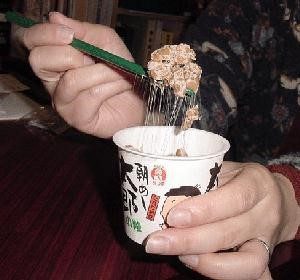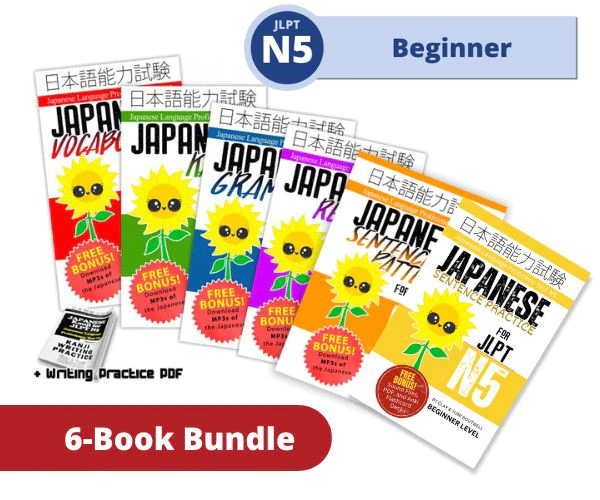21
21. To Like—すき suki
It is easy to like something and to say it! Just add the particle が ga and the word すき suki (like) after the object that you like:
ねこ が すき です。
neko ga suki desu.
I like cats.
Note: In Japanese, nouns do not change their form in order to indicate whether or not they are plural. For example, in English we say “cat” for one cat, and “cats” for two or more cats. In Japanese they are both neko. You have to understand from context whether it is plural or not. Also note the desu, if dropped, makes the sentence more casual: “neko ga suki.”
Like “desu,” “suki” often isn’t pronounced (at least as English speakers would consider it) as two syllables. It usually sounds like “ski.”
22
22. Why / Because—なぜ・どうして naze / doushite
Let's look at two common ways to express "why":
なぜ naze – why
どうして doushite – why
They are basically interchangeable and appear at the beginning of the sentence and are followed by the question.
なぜ(どうして) 私 の ケーキ を たべました か?
naze (doushite) watashi no ke-ki o tabemashita ka?
Why did you eat my cake?
[“You” is understood from the context and need not be spoken.]
An easy way to answer or give a reason (because) for the question is:
なぜなら nazenara + reason or excuse + kara
なぜなら はら が へった から。
nazenara hara ga hetta kara.
Because, (I was) starving!
[Lit. because stomach was empty]
23
23. I think—とおもいます to omoimasu
This goes at the end of a sentence when giving one’s opinions or feelings about something.
Just think of と思います to omoimasu as “I think that...”
If there is a desu, change it to da which is the more casual form and add to omoimasu.
熊のプーさん は くま だ と 思います。
kuma no pu-san wa kuma da to omoimasu.
I think Winnie the Pooh is a bear.
[“kuma no pu-san” is Winnie the Pooh in Japanese. Characters that are animals are often written like this: type of animal + no + name]
The next example shows one’s opinion. It is true for the speaker but may not be so for the listener.
なっとう は おいしい と 思います。
nattou wa oishii to omoimasu.
I think natto* is delicious.
In addition to its obvious meaning, you can also add this to any sentence if you want to soften it, show uncertainty, or show your opinion.

*Natto is a traditional Japanese food made from fermented soybeans. Many foreigners stay clear due to the strong... stink. But it is said to be healthy and is enjoyed by many—but not all Japanese.
24
24. Become—になります ni narimasu
To show the state of becoming... something, use ~に なります ni narimasu. The に ni is placed after what is becoming something. Nouns and -na adjectives use ni narimasu. -i adjectives are different, but for now there are enough useful nouns to look at:
夜 に なりました。
yoru ni narimashita.
It has become night.
[~mashita shows past]
友達 に なりましょう。
tomodachi ni narimashou.
Let’s become friends.
[the ~mashou means “let’s”—we will look at that more closely in a few lessons.]
げんき に なりました。
genki ni narimashita.
(I) have become fine / healthy. (I feel better)
25
25. Also—も mo
も mo means “also” or “too” and like other particles, it is placed after the word it modifies.
Let’s see some examples:
PERSON A:
私 は ねこ が すき。
watashi wa neko ga suki.
I like cats.
PERSON B:
私 は ねこ が すき、そして いぬ も すき。
watashi wa neko ga suki, soshite inu mo suki.
I like cats, and I also like dogs.
[The も mo after いぬ inu replaces が ga. You don't say “ga mo”]
PERSON C:
私 も ねこ と いぬ が すき。
watashi mo neko to inu ga suki.
I also like cats and dogs.
NOTE: わたしも watashi mo by itself means “Me too.”
26
26. Making the て te Form
If you know how to make this form, you can do a lot! Later we will look at other grammar points that are based on the te form. By itself, it makes a verb a request (or demand).
There are three types of verbs. It is beyond the scope of this article to go into them in detail, but for now try to memorize each example.
1. のむ nomu (to drink) becomes
のんで nonde (please drink)
2. たべる taberu (to eat) becomes
たべて tabete (please eat)
3. する suru (to do) becomes
して shite (please do)
If you memorize the three examples above you should be able to guess what other verbs may change to. Or even if you guess wrong, the correct form should be at least familiar to you.
To make this politer, add ください kudasai.
のんでください。
nonde kudasai.
Please drink.
27
27. To Do; Play—する・します suru / shimasu
する suru goes where no other verb dares to go! Think of it as “to do...”
Most loanwords used as verbs add “suru,” for example:
ジョギング する jogingu suru - to (do) jogging
ショッピング する shoppingu suru - to (do) shopping
サイン する sain suru - to sign (autograph)
USEFUL JAPANESE + SURU
勉強する benkyou suru - to study
毎日、 日本語 を 勉強 します。
mainichi, nihongo o benkyou shimasu.
Everyday, (I) study Japanese.
Another usage of suru -or- shimasu (remember they are the same, but “suru” is more casual) is “to play” as in sports or games
野球 を する
yakyuu o suru.
To play baseball.
相撲 を する。
sumou o suru.
To play (do) Sumo.
バスケット を する。
basuketto o suru.
To play basketball.
将棋 を する。
shougi o suru.
To play shogi (Japanese chess)
28
28. More, ~er—もっと motto
One easy way to say “MORE” or “-er” is to use もっと motto. This is one of the rare times that the word order is the same as English—or at least with the more part! Relish the moment (while you can).
[motto ~ = more ~]
もっと ピーマン を 食べなさい。
motto pi-man o tabenasai.
Eat more green peppers.
[~nasai is like the te form in that it is used to give commands, but it is stronger.]
AND FOR THE:
[motto ~ = ~er]
もっと はやく 言って ください。
motto hayaku itte kudasai.
(Next time) please say (it) a little earlier (faster).
[Useful when someone tells you NOT to cut the yellow wire of the bomb after you have done just that...]
29
29. Can Do—できます dekiru / dekimasu
There are a couple of ways to say “I can...” in Japanese. The easiest is できます dekimasu. Let’s look at how to form some sentences.
NOUN [できます dekimasu]
日本語 が できます。
nihongo ga dekimasu.
I can do Japanese. [I can understand/write/etc Japanese.]
漢字 が できます。
kanji ga dekimasu.
I can (read/write) kanji. [I can do kanji.]
スカイダイビング が できます。
sukaidaibingu ga dekimasu.
I can skydive.
VERB [こと が できます koto ga dekimasu]
Actually, all of the above could include a verb. Let’s add it. こと koto means “thing,” but here it is used to make a verb into a noun phrase so it will work with できます dekimasu.
日本語 を 話す こと が できます。
nihongo o hanasu koto ga dekimasu.
I can speak Japanese.
漢字 を 読む こと が できます。
kanji o yomu koto ga dekimasu.
I can read kanji.
Be creative and come up with things you can do! Again, memorize an example sentence. Go around saying “Nihongo ga dekimasu! Nihongo ga dekimasu!”
30
30. –ing—ている。ています ~te iru / ~te imasu
This is a very important grammar point. It corresponds to the English “-ing” form
EAT becomes EATING
たべます becomes たべています
CONSTRUCTION: て te form + います imasu or いる iru
Use this to describe things happening now.
今 あなた に 話して います。
ima anata ni hanashite imasu.
I am talking to you now.
今 ごはん を 食べて います。
ima gohan o tabete imasu.
I am eating rice (food) now.
And finally, when answering your phone in mid-air:
今 スカイダイビング を して います。
ima sukaidaibingu o shite imasu.
I am skydiving now.
To make a question just add ka to the end.
あなた は 勉強 して います か?
anata wa benkyou shite imasu ka?
Are you studying?
~ている ~te iru can also be used to express habitual actions, but the most common usage—and the one we are studying—is as above. benkyou shite iru?
31
31. For Example—たとえば tatoeba
Anytime you want to make an illustration or give an example, this is the phrase to use.
私 は 和食 が 好き です。
watashi wa washoku ga suki desu.
I like Japanese style food.
たとえば、ごはん と みそ汁。
tatoeba, gohan to misoshiru.
For example, rice and miso soup.
You can also ask someone this to get more concrete information.
たとえば、 何?
tatoeba, nani?
For example, what?
32
32. This—これ・この kore / kono
This and that.
Actually, Japanese also has one more. They also have “that over there”—but we will get at that later.
There are two words in Japanese that are translated as “this” in English.
これ kore
this - When “this” is not connected to a noun — hang on you will understand in a minute.
これ は 何 です か?
kore wa nan desu ka?
What is this?
これ は ねこ です。
kore wa neko desu.
This is a cat.
HINT: To say “This is” or “is this” the これ kore will probably be followed by a は wa (topic particle). Or if the topic is established, it will be が ga.
この kono
When you put “this” before a noun, it should be kono
この ねこ は ポチ です か?
kono neko wa pochi desu ka?
Is this cat, Pochi?
Notice the “neko” is a noun. To say “this cat” you need to use “kono” and not "kore" for "this."
いいえ。 この 犬 は ポチ です。
iie kono inu wa pochi desu.
No. This dog is Pochi.
Cultural Note: “Pochi” is a generic name for dogs in Japanese, similar to “Fido.”
33
33. That—それ・その sore / sono
This and that. Remember there are actually two “that” words. This THAT refers to objects near the listener (not the speaker). The next lesson will cover the last THAT (that over there).
As with これ and この, there are two forms--one by itself and one before nouns.
それ sore
when “that” is not connected to a noun
それ は 何 です か?
sore wa nan desu ka?
What is that?
それ は ねこ です。
sore wa neko desu.
That is a cat.
HINT: Begin to think of these words starting with K’s as “this” and the S’s as “that” words.
その sono
When you put “that” before a noun, use sono.
その ねこ は ポチ です か?
sono neko wa pochi desu ka?
Is that cat, Pochi?
いいえ。 その たこ は ポチ です。
iie. sono tako wa pochi desu.
No. That octopus is Pochi.
HINT: This is used in the same way as kono.
34
34. That Over There—あれ・あの are / ano
This and that. Now, we are on the THAT OVER THERE part. So this THAT refers to objects not near the listener or the speaker.
あれ are
when “that” is not connected to a noun.
あれ は 何 です か?
are wa nan desu ka?
What is that over there?
あれ は ねこ です。
are wa neko desu.
That over there is a cat.
HINT: And now recognize the A’s mean “That over there.”
あの ano
When you put “that” before a noun, it changes to ano:
あの ねこ は ポチ です か?
ano neko wa pochi desu ka?
Is that cat over there Pochi?
いいえ。 あの くじら は ポチ です。
iie ano kujira wa pochi desu.
No. That whale over there is Pochi.
35
35. Must do—なければなりません ~nakereba narimasen
This is a mouthful! But it is especially nutritious for your overall vocabulary diet. Learn it well.
Construction: plain negative verb - i + ければ なりません kereba narimasen
[The plain negative form is tabenai drop the -i and add the “kereba narimasen.”]
ピーマン を 食べなければ なりません。
pi-man o tabenakereba narimasen.
(I) must eat green peppers.
(Many Japanese children don’t like green peppers)
Say that five times fast with your mouth full!
Perhaps the most useful usage is:
~しなければ なりません
~shinakereba narimasen
The shi is from suru (to do)
勉強 しなければ なりません。
benkyou shinakereba narimasen.
(I) must (have to) study.
しなければ なりません。
shinakereba narimasen.
(I) must (have to) do (it).
36
36. Better to... —ほうがいい hou ga ii
When giving advice, this is useful.
CONSTRUCTION: ta form + ほう が いい hou ga ii
休んだ ほう が いい。
yasunda hou ga ii.
It would be better to rest.
聞いた ほう が いい。
kiita hou ga ii.
It would be better to ask (someone).
NOTE: The ta form is the same as the simple past tense.
37
37. Better / Worse Than—のほうが~より no hou ga ~ yori
This has the same hou ga ii as the previous entry. But here we are using it to compare things. Also we will introduce yori (less than).
~の ほう が いい
~no hou ga ii
(more than)
~より
~yori
(less than)
This is a little confusing, so I suggest memorizing one or two examples to keep it straight.
わたし は いぬ より ねこ の ほう が 好き。
watashi wa inu yori, neko no hou ga suki.
I like dogs less than cats. (I like cats more than dogs.)
You should spend some time studying the above example to understand how the ordering works.
Notice in English we use either “less than” or “more than” and the meaning is understood by the order of “dogs” and “cats” BUT in Japanese this is also OK:
わたし は ねこ の ほう が、 いぬ より 好き。
watashi wa neko no hou ga, inu yori suki.
I like cats more than dogs.
38
38. How... —どう dou?
Here is a very useful question word—dou—Let’s look at ways of using dou.
どう です か?
dou desu ka?
How is (it)?
[Use this for asking about food, work situations, relationships, or anything that is happening now.]
どう でした か?
dou deshita ka?
How was (it)?
[Use this to find out about past experiences—movie, last night’s date, the molded pizza your friend just ate...]
OTHER WAYS!
どうやって?
dou yatte?
How do you do it?
[Ask this when you are not sure how to do something.]
どう しました か?
dou shimashita ka?
What happened?
[Ask this if someone looks like something the cat dragged in.]
どうしよう。
dou shiyou.
What shall (I or we) do?
[This is often used when you can’t make a decision and want help.]
どう する の?
dou suru no?
What will you do?
[When you want to encourage someone to make a decision — Well, what will you do?]
39
39. Isn’t it? —でしょう? deshou?
If you say something but want confirmation that the listener agrees, use deshou.
フィリピンは暑いでしょう?
firipin wa atsui deshou?
The Philippines is hot, isn’t it?
[You are expecting a “yes” answer]
痛いでしょう?
itai deshou?
It hurts, doesn’t it?
[You see someone who has just slammed his head in a low doorway. You are expecting a “yes” answer.]
雨が降るでしょうね。
ame ga furu deshou ne.
It will probably rain, don’t you think?
And another common usage is どうでしょう dou deshou meaning “how about...?” or “what do you think about?”
うどんはどうでしょう?
udon wa dou deshou?
How about some udon?
40
40. Said—といいました to iimashita
Meet the wonderful “と to.” Mr. と can act as a quotation marker (“”). Don’t confuse this with the と to that means “and.”
Use this when quoting someone or some quote-like thing. This is best shown with examples:
「おれはスーパマン」と言いました。
ore wa su-paman to iimashita.
He said, “I am Superman.”
あの絵は十世紀につくったと書いてあります。
ano e wa juu seiki ni tsukutta to kaite arimasu.
It says (a book or description) that this painting was made in the tenth century.
It can also be used to mark sound effects. For example:
あの犬は「ワン」と言いました。
ano inu wa wan to iimashita.
That dog barked, “bark.”
There are many other usages for “to.” Paying attention to each usage will help you get a good grasp.



